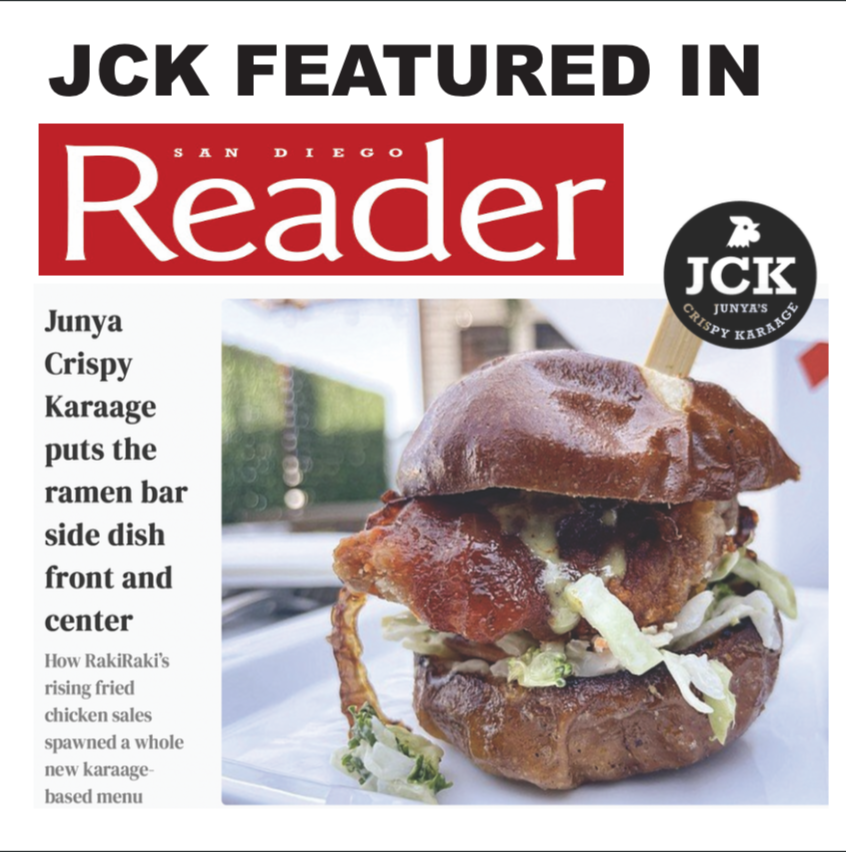
Junya Crispy Karaage Puts the Ramen Bar Side Dish Front and Center
There’s a good reason I have been writing about fried chicken over and over in the past year: it’s become more popular than ever. And not only because Nashville hot chicken has been having a moment in San Diego. Nationwide, people have ordering fried chicken of all stripes, so often, you would almost think it had been hyped alongside hydroxychloroquine as a covid remedy.
Junya Watanabe witnessed it first-hand. The chef and founder of RakiRaki Ramen tells me that as take-out and delivery orders for his ramen business went up after the pandemic started, so too did orders for chicken karaage. Which his noodle restaurants offered almost incidentally, as a matter of form. In Japan, he says, this Japanese version of fried chicken is offered as an appetizer in just about every ramen bar.
However, after seeing the frequency of karaage orders on his ramen receipts, he decided it was time to redouble his focus, update the recipe, and spin off a whole new brand. The result is JCK: Junya’s Crispy Karaage.
Watanabe has a history of spinning off new concepts. Five years ago, he helped kick off the local sushi burrito craze with Pokirrito. Around the same time, he launched the j/wata Temaki Bar, which specialized in made-to-order sushi hand rolls. Early last year, he delved into vegan sushi with the launch of The Yasai.
Now, Junya’s Crispy Karaage has opened in the same Kearny Mesa location where he operates the original RakiRaki, and a Yasai counter. The interconnected restaurants, their dining rooms, and patios will all soon fall under the umbrella, RakiRaki Commons.
And yes, consider the karaage upgraded. As he did with his original ramen recipes, Watanabe consulted with chefs in his native Tokyo to learn the secrets of a proper karaage
JCK’s hormone- and antibiotic-free fried chicken is marinated overnight in shoyu and vinegar, coated with a blend of flour and seasoning that includes curry powder, and fried to an impressive crisp, without being greasy. Strips of it are served in a cardboard box printed in red and white colors that, like the JCK brand, nod to “finger licking good” Southern fried chicken fast-food chain currently known as KFC.
Fried chicken orders include dipping sauces, including spicy kewpie mayo to ponzu, and of course there’s a spicy option, coated in a sauce made with eight types of Japanese chili pepper. Other fried chicken options include sliders with sesame coleslaw, and a curry rice dish, featuring his Setagaya 27 curry — named for the famed curry district of Tokyo that inspired it, and the 27 spices responsible for its flavor.
Probably the most interesting karaage dish on the menu is a bowl of ramen, employing the fried chicken strips served over a bowl of RakiRaki chicken broth and thick, house-made noodles. If you’re looking for a good reason to revisit RakiRaki’s ramen, do it for those noodles, which are now made with a bit of mochi.
That would be the rice flour product responsible for gummy-like Japanese tea cakes and Mochinuts, the extra chewy donut shop that immediately drew long lines when it opened across from RakiRaki this spring. As you might expect, a little mochi lends a lot of elasticity to these thick ramen noodles, too. Which makes fried chicken ramen the rare all-in-one dish you can slurp, crunch, and chew. Kind of fitting for a location known to feature a collection of Japanese food trends under one roof.